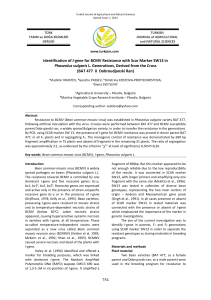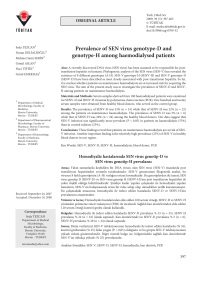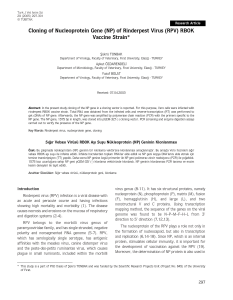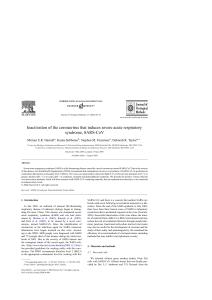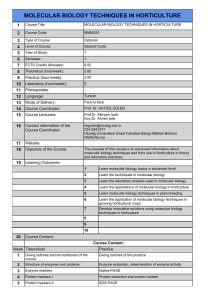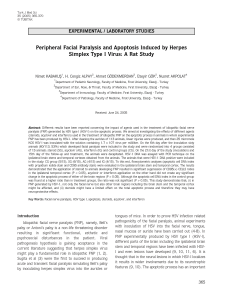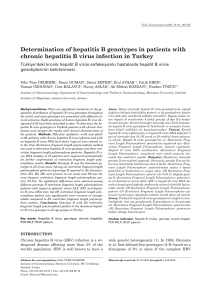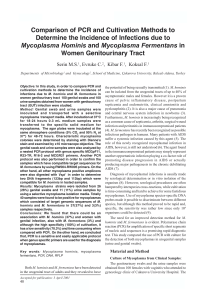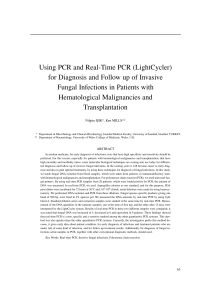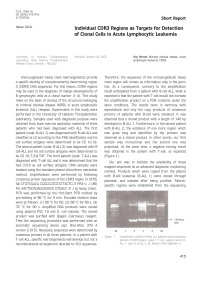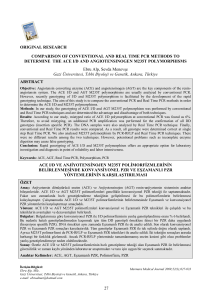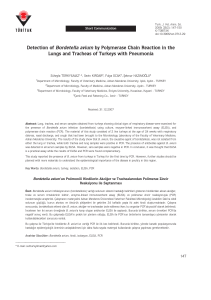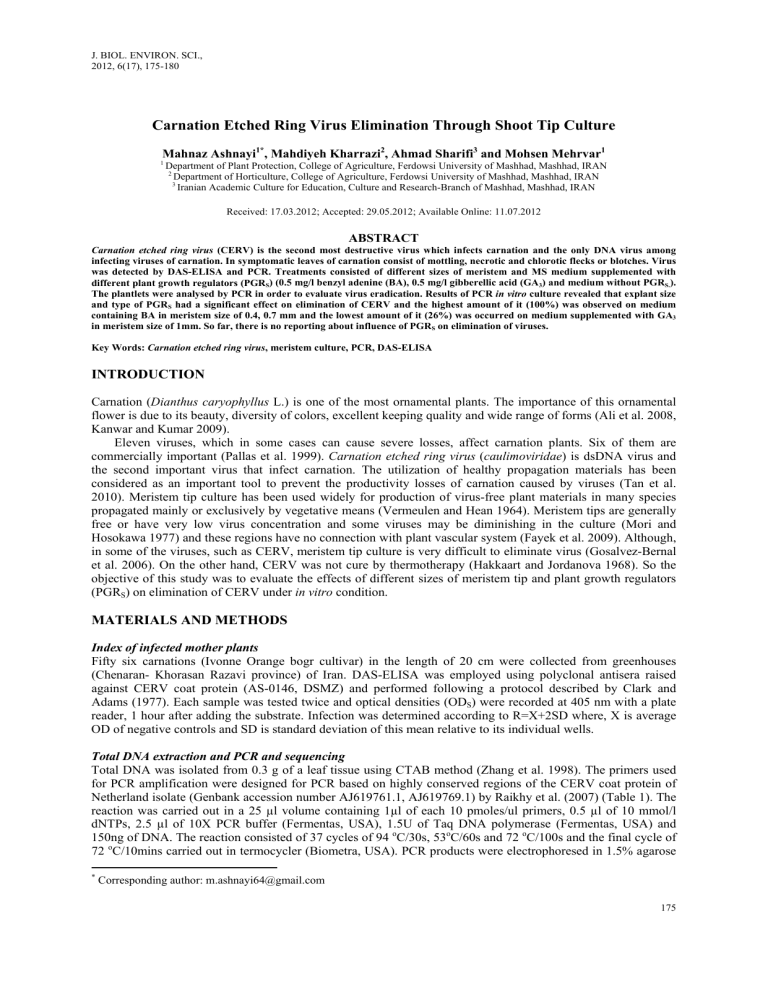
J. BIOL. ENVIRON. SCI.,
2012, 6(17), 175-180
Carnation Etched Ring Virus Elimination Through Shoot Tip Culture
Mahnaz Ashnayi1*, Mahdiyeh Kharrazi2, Ahmad Sharifi3 and Mohsen Mehrvar1
1
Department of Plant Protection, College of Agriculture, Ferdowsi University of Mashhad, Mashhad, IRAN
2
Department of Horticulture, College of Agriculture, Ferdowsi University of Mashhad, Mashhad, IRAN
3
Iranian Academic Culture for Education, Culture and Research-Branch of Mashhad, Mashhad, IRAN
Received: 17.03.2012; Accepted: 29.05.2012; Available Online: 11.07.2012
ABSTRACT
Carnation etched ring virus (CERV) is the second most destructive virus which infects carnation and the only DNA virus among
infecting viruses of carnation. In symptomatic leaves of carnation consist of mottling, necrotic and chlorotic flecks or blotches. Virus
was detected by DAS-ELISA and PCR. Treatments consisted of different sizes of meristem and MS medium supplemented with
different plant growth regulators (PGRS) (0.5 mg/l benzyl adenine (BA), 0.5 mg/l gibberellic acid (GA3) and medium without PGRS.).
The plantlets were analysed by PCR in order to evaluate virus eradication. Results of PCR in vitro culture revealed that explant size
and type of PGRS had a significant effect on elimination of CERV and the highest amount of it (100%) was observed on medium
containing BA in meristem size of 0.4, 0.7 mm and the lowest amount of it (26%) was occurred on medium supplemented with GA3
in meristem size of 1mm. So far, there is no reporting about influence of PGRS on elimination of viruses.
Key Words: Carnation etched ring virus, meristem culture, PCR, DAS-ELISA
INTRODUCTION
Carnation (Dianthus caryophyllus L.) is one of the most ornamental plants. The importance of this ornamental
flower is due to its beauty, diversity of colors, excellent keeping quality and wide range of forms (Ali et al. 2008,
Kanwar and Kumar 2009).
Eleven viruses, which in some cases can cause severe losses, affect carnation plants. Six of them are
commercially important (Pallas et al. 1999). Carnation etched ring virus (caulimoviridae) is dsDNA virus and
the second important virus that infect carnation. The utilization of healthy propagation materials has been
considered as an important tool to prevent the productivity losses of carnation caused by viruses (Tan et al.
2010). Meristem tip culture has been used widely for production of virus-free plant materials in many species
propagated mainly or exclusively by vegetative means (Vermeulen and Hean 1964). Meristem tips are generally
free or have very low virus concentration and some viruses may be diminishing in the culture (Mori and
Hosokawa 1977) and these regions have no connection with plant vascular system (Fayek et al. 2009). Although,
in some of the viruses, such as CERV, meristem tip culture is very difficult to eliminate virus (Gosalvez-Bernal
et al. 2006). On the other hand, CERV was not cure by thermotherapy (Hakkaart and Jordanova 1968). So the
objective of this study was to evaluate the effects of different sizes of meristem tip and plant growth regulators
(PGRS) on elimination of CERV under in vitro condition.
MATERIALS AND METHODS
Index of infected mother plants
Fifty six carnations (Ivonne Orange bogr cultivar) in the length of 20 cm were collected from greenhouses
(Chenaran- Khorasan Razavi province) of Iran. DAS-ELISA was employed using polyclonal antisera raised
against CERV coat protein (AS-0146, DSMZ) and performed following a protocol described by Clark and
Adams (1977). Each sample was tested twice and optical densities (ODS) were recorded at 405 nm with a plate
reader, 1 hour after adding the substrate. Infection was determined according to R=X+2SD where, X is average
OD of negative controls and SD is standard deviation of this mean relative to its individual wells.
Total DNA extraction and PCR and sequencing
Total DNA was isolated from 0.3 g of a leaf tissue using CTAB method (Zhang et al. 1998). The primers used
for PCR amplification were designed for PCR based on highly conserved regions of the CERV coat protein of
Netherland isolate (Genbank accession number AJ619761.1, AJ619769.1) by Raikhy et al. (2007) (Table 1). The
reaction was carried out in a 25 µl volume containing 1µl of each 10 pmoles/ul primers, 0.5 µl of 10 mmol/l
dNTPs, 2.5 µl of 10X PCR buffer (Fermentas, USA), 1.5U of Taq DNA polymerase (Fermentas, USA) and
150ng of DNA. The reaction consisted of 37 cycles of 94 oC/30s, 53oC/60s and 72 oC/100s and the final cycle of
72 oC/10mins carried out in termocycler (Biometra, USA). PCR products were electrophoresed in 1.5% agarose
*
Corresponding author: [email protected]
175
J. BIOL. ENVIRON. SCI.,
2012, 6(17), 175-180
gel in 1X TAE buffer (0.04 mol/l, Tris-acetate and 0.001mol/l EDTA) stained with green viewer and observed
under UV transilluminator and photographed using Gel documentation system.
Table 1. Primer pairs used for the detection of carnation etched ring virus (CERV) and amplicon produced by polymerase chain reaction.
Primer
CPU
CPD
Position based on
NC-003498.1
1901-1872
3356-3327
Sequence
Amplicon size
(bp)
TCCCCCGGGGGAATGAATAGAGAAGCTAT
TCCCCCGGGGGATCATTCCGATTCTTCAG
1500
Purified PCR product (Bioneer, Seoul) and was used for sequencing. Both strands of DNA were sequenced
by the dideoxy chain termination method, using an automated sequencer (ABI 3730xl DNA Analyzer, Applied
Biosystems, USA) and the ABI BigDye® Terminator Version 3.1 Ready Reaction Cycle Sequencing Kit
(Applied Biosystems). The nucleotide sequence of the Iranian isolate was deposited at the NCBI nucleotide
dadabase under the Acc.No. JF957838.
Carnation Meristem Culture
Explants sterilization
Stem segments of carnation were selected in their active growth stage. After defoliation, shoot explants about 56 cm length were washed thoroughly with tap water for 30 minutes and surface sterilization was done by
immersing them in 2% sodium hypochlorite solution containing Tween 20 (2drop/100ml solution) for 15
minutes. Then explants were rinsed 3 times with sterile distilled water.
Medium and plant establishment
Meristem tips in different sizes (0.4 mm: meristem without primordial; 0.7 mm: meristem with primordial; 1mm:
meristem with primordia and small stem) (Fig. 1) were cultured on MS medium containing one of PGRs, benzyl
adenine (0.5 mg/l), gibberelic acid (0.5 mg/l) and without any PGRs, 30 g/l sucrose, 8 g/l agar (Fig. 2, 3). The
pH of the medium was adjusted to 5.7- 5.8 and autoclaved. The cultures were incubated in a growth chamber at
25±2oC under 16 h light conditions. Subcultures were done every 4 weeks.
Figure 1. Different sizes of meristem. (A: meristem without primordial. B: meristem with primordia. C: meristem with primordia and small
stem)
176
J. BIOL. ENVIRON. SCI.,
2012, 6(17), 175-180
Figure 2. Effect of PGRS on vegetative growth of carnation. (A: Medium with 0.5 mg/l gibberelic acid, B: Medium without any PGRS, C:
Medium with 0.5 mg/l benzyl adenine).
Figure 3. Different growth stage of carnation in vitro in medium supplemented with GA3 (0.5 mg/l). A, B, C and D, respectively, 1, 2, 4 and
6 weeks after culturing.
Statistical analysis
A completely randomized design with ten replications was used. Treatment were verified based on ANOVA
using MSTAT-C program and the means were compared using Duncan multiple range test (DMRT) at P≤0.01.
RESULTS AND DISCUSSION
Many factors influence the in vitro culture of carnation (Kharrazi et al. 2011). The factors considered in this
study were the effect of different PGRs and explant size on shoot multiplication of carnation. Kind of PGRs in
subculture stage affected on establishment, thus significant differences occurred among explants as shown in
Table 2.
177
J. BIOL. ENVIRON. SCI.,
2012, 6(17), 175-180
Table 2. The effect of the meristem tip size and kind of PGRS on the production of carnation etched ring virus-free plantlets.
1
26% (4-15)
4.76% (1-21)
Size of explants (mm)
0.7
9% (1-11)
0% (0-8)
Kind of PGRS
GA3 (0.5 mg/l)
BA (0.5 mg/l)
0.4
9% (1-11)
0% (0-9)
The effect of different kind of PGRs and explant size
The results of this experiment showed that the size of explants and kind of PGRs had a significant influence on
rate of vitrification, rooting and height of explant. The highest amount of shoots number (5.1) was observed on
medium containing BA in meristem with primordia and small stem explant. Significant differences were not
occurred between different sizes of explants on medium containing BA, although in this medium, increasing size
of explant led to increasing the rate of shoot regeneration. In addition, there was not shoot regeneration in the
media supplemented with GA3 (0.5 mg/l) and without PGRs and in GA3 containing medium, primary explants
grew up normally, while in the medium without any PGRs there was little growth that considered as a failure to
growth. Our results are in close agreement with Dagnino et al. (1991) that indicate GA3 increase longitudinal
growth of explant and did not have any influence on shoot regeneration (Table 3).
Table 3. Interaction effects of growth regulator type and explant type on some growth characteristic of carnation during in vitro condition.
Type of
growth
regulator
0.5 mg/l
GA3
Explant size
(mm)
Height of
grown shoot
(cm)
Rate of
vitrification
(%)
Rate of
rooting
(%)
Number of
regenerated
shoot
1
2. 90 a*
0.00 e
100.00 a
0.00 b
0.7
2.26 b
10.00 d
100.00 a
0.00 b
0.4
2.20 b
20.30 c
81.80 b
0.00 b
1
1.46 c
51.60 b
22.00 d
5.10 a
0.7
1.64 c
50.00 b
0.00 e
4.80 a
0.4
0.96 d
59.30 a
0.00 e
4.50 a
1
0.52 de
10.70 d
60.60 c
0.00 b
0.7
0.36 e
10.90 d
59.40 c
0.00 b
0.4
0.37 e
18.00 c
0.00 e
0.00 b
0.5 mg/l BA
Without any
PGRs
Means with similar letters in each column are not significantly different by Duncan’s multiple range test (p<0.05).
In all explants, the maximum percentage of vitrification was observed in the media supplemented with BA.
The highest amount of vitrification (59.30%) was observed on medium containing BA (0.5 mg/l) in meristem
explants and the lowest amount of it (0%) was observed on medium containing GA3 (0.5 mg/l) in meristem with
primordial and small stem explant (Table 3). Our results are similar to Jain et al. (1997) and Jain et al. (2001)
reports but in contrast to the finding of kim et al. (1998).
Mean comparison showed that size of explant and kind of PGRS significantly influenced the height of plantlet.
The highest height of plantlet (2.90 cm) was in medium containing GA3 and meristem with primordia and small
stem, while the lowest amount of it (0.36 cm) was observed in medium without any PGRs and meristem with
primordia. In all sizes of explants, BA led to production of shorter plantlets in compare with GA3 (Fig1-C).
These results are in close agreement with finding of Jain et al. (1997).
178
J. BIOL. ENVIRON. SCI.,
2012, 6(17), 175-180
The results showed smaller sizes of explant caused deduction in rooting rate. The highest root percentage for
all sizes of explant were achieved on the medium supplemented with 0.5 mg/l GA3, while no rooting was shown
on the medium enriched with 0.5 mg/l BA and MS medium without any PGRs (Table3). These results are in
according with the finding of Ullah et al. (2007) and Fayek et al. (2009). Our results and previous studies (Vu
and Yelenosky 1988) have shown that application of BA in the medium stimulated micropropagation stage and
the number of regenerated shoots, as BA stimulated the rate of mitotic process (Kiss et al. 2001), it is expected
BA led to increase in shoot dry weight, number of leaf and leaf area index (data was not shown).
Virus detection
Primary index was done by ELISA, because our aim was selection of the most infected plants, although virus
testing to confirm the infection carried out by PCR followed by sequencing. However, ELISA lacks the
sensitivity required for the detection of virus, which occur in low concentration in these tissues. Furthermore,
secondary index of virus elimination was performed by PCR. In PCR, the expected amplification of 1500bp was
obtained in virus infected plants (naturally and in vitro grown) with CERV, while no amplification was obtained
in CERV free plants (Fig. 4).
Figure 4. Agarose gel electrophoresis analysis of PCR product from total DNA extracted from carnation tissues individually infected with
CERV. Lane 1, negative control. Lan 2, the virus specific amplified band 1500 bp. Lane 3, positive control. Lane M, 100 bp ladder.
Effect of meristem size on its establishment and virus elimination
Meristem tip of 0.4 mm size were found to be optimum for CERV elimination from infected carnations. Larger
sizes of meristem (0.7 and 1 mm) in many cases were found to be virus infected (Table 2). This results and
earlier study (Mori and Hosokawa 1977) show the elimination ratio of virus was higher when the size of
meristem tip was smaller, although elimination limit of viruses differ considerably by the species of plants and
viruses.
As it clear from the data in Table 2, there is a significant difference between two kinds of PGRs (BA and GA3) in
virus elimination. The most virus elimination was occurred on the culture medium enriched with BA. Although
so far there is no report about influence of PGRs on virus elimination.
CONCLUSIONS
It become clear from the results, the relation between the size of explants to produce virus-free plantlets are
generally in parallel, But effective size to produce virus- free plantlet independent on distribution, concentration
or probably mixed infection virus in shoot apex of virus infected plants.
According to our results, meristem size 0.4 and 0.7 and medium containing enriched with BA is
recommended to elimination of CERV using meristem tip culture under in vitro condition. Based on the results
of this study, it can be concluded that simultaneously BA decreases infection of virus, and at the same time it
increases the rate of vitrification. Consequently it is suggested that for obtaining normal plantlets with minimum
179
J. BIOL. ENVIRON. SCI.,
2012, 6(17), 175-180
vitrification rate, lower concentration of BA should be used in the medium. More researches should be done for
approaching to the method that led to increase the production of virus-free plantlet without any problem of
vitrification at commercial levels.
REFERENCES
Ali A, Afrasiab H, Naz S, Rauf M, and Iqhbal J (2008). An efficient protocol for in vitro propagation of carnation (Dianthus caryophyllus
L.). Pak. J. Bot. 40: 111-121.
Clark MF and Adams NA (1977). Characteristics of the microplate method of enzyme-linked immunosorbant assay for the detection of plant
viruses. J.G.V. 34: 475-483.
Dagnino DS, Carelli MLD, Arrabal RF, and Esquibel MA (1991). Effect of gibberellic acid on Ipomoea batatats regeneration from meristem
culture. Pesq. Agropec. Bras. Brasflia. 26(2): 259-262.
Fayek MA, Jomaa AH, Shalaby AA, and Al-Dhaher MA (2009). Meristem tip culture for in vitro eradication of grapevine leaf rollassociated virus-1 (GLRaV-1) and grapevine fan leaf virus (GFLV) from infected flame seedless grapevine plantlets. Iniciacion a la
investigation. 4:1-11.
Gosalvez-Bernal B, Garcia-castillo S, Pallas V, and Sanchez-pina MA (2006). Distribution of carnation viruses in the shoot tip: exclusion
from the shoot apical meristem. Physiol. Mol. Plant P. 69: 43- 51.
Hakkaart FA, and Jordanova J (1968). Heat treatment experiments with carnations for the elimination of carnation mottle and etched ring
viruses. Plant Pathol. 74: 146-149.
Jain A, Kanita A, and Kothari SL (2001). De novo differentiation of shoot buds from leaf-callus of Dianthus caryophyllus L. and control of
hyperhydricity. Sci. Hort. 87(4): 319-326.
Jain A, Hussain S, and Kothari SL (1997). Micropropagation of Dianthus caryophyllus L. control of vitrifcation. J. Plant. Biochem.
Biotechnol. 6: 35-37.
Kanwar JK and Kumar S (2009). Influence of growth regulators and explants on shoot regeneration in carnation. Hor Sci. 36: 140-146.
Kim KW, Byun MS, and Kang MS (1988). Effects of ABA and agar in preventing vitrification of carnation plantlets cultured in vitro. J.
Korean Soc. Hort. Sci. 29: 208-215.
Kharrazi M, Nemati H, Tehranifar A, Bagheri A, and Sharifi A (2011). In Vitro Culture of Carnation (Dianthus caryophyllus L.) Focusing on
the Problem of Vitrification. JBES, 1(13): 159-164.
Pallas V, Sanchez-Navarro JA, Canizares MC, and Cano EA. (1999). A new test for detecting carnation viruses. Floraculture Int. 9: 32-34.
Raikhy G, Hallan V, Kulshrestha S, and Zaidia, A (2007). Polyclonal antibodies to the coat protein of Carnation etched ring virus expressed
in bacterial system: Production & use in immunodiagnosis. J. Phytopathol. 155:616-622.
Ullah F, Abbas Z, and Abbas SJ (2007). In vitro effects of gibberellic acid on morphogenesis of potato explant. Int. J. Agric. Biol. 9:181-182.
Vu JCV, and Yelenosky G (1988). Biomass and photosynthesis responses of rough lemon (Citus jambhirl Lush.) to growth regulators. Can.
J. Plant Sci. 68: 261-266.
Zhang YP, Uyemoto JK, and Kirkpatrick BC (1998). A small-scale procedure for extracting nucleic acids from woody plants infected with
various phytopathogens for PCR assay. J. Virol. Methods. 71: 45-50.
180

